Why is API integration for fuel delivery apps important?
Well, to answer this, let’s imagine a scenario, first.
Picture this: As a consumer of fuel, it's 6 AM on a Monday, your fuel gauge is blinking red, and you're already running late for work. What will you expect, a fuel delivery system that can reach you in max 30 minutes, right?
Well, if you are picturing this scenario, then it is true that it is already happening with lots of people in the world.
Want to convert this opportunity into success?
Then it's the right time to enter the fuel delivery app industry.
"The best way to predict the future is to create it" - Peter Drucker
This quote is true; however, as per present circumstances, you should evaluate what competitors are doing and how they are performing in this competitive dynamic world. Then identify the gap and address it with your project solution.
Unlike typical delivery apps, fuel delivery platforms face unique challenges: safety regulations and environmental compliance. Success depends on integrating the right APIs while maintaining security, performance, and scalability.
That’s where API integration for fuel delivery apps is crucial.
Now that you have the role of APIs, in this blog, we will discuss the complete concept of API integration for fuel delivery apps, different APIs, cost, and challenges.
Let’s begin, together.
Key Takeaways:
Boost app functionality: API integration powers essential features like payments, mapping, and real-time fuel data.
Enhance user experience: Seamless API connections provide faster service, accurate tracking, and secure transactions.
Ensure market competitiveness: Strategic API use allows for dynamic pricing and efficient operations, staying ahead of rivals.
Streamline operations: APIs optimize fleet management, communication, and inventory, reducing manual efforts.
Invest wisely: Essential API integration for core features typically costs between $12,000 and $20,000.
Ensure seamless integration: Partnering with experts like JPLoft helps mitigate risks and optimize API performance.
Understanding the Fuel Delivery App Ecosystem
When integrating Application Programming Interfaces (APIs) into applications, it is essential to be familiar with the market and ecosystem details.
This will help you make informed decisions regarding your fuel delivery API Integration.
Hence, let’s learn about the fuel delivery app ecosystem first.
The fuel delivery app ecosystem comprises on-demand fuel delivery services, where users can order fuel for their vehicles via a mobile application. Additionally, they can deliver it to their location.
A fuel delivery app ecosystem involves the integration of different components to provide on-demand fuel delivery facilities effectively to potential users.
Additionally, the fuel delivery apps aim to provide a convenient and most efficient way for users to get fuel at their location. These apps do allow users to request fuel delivery to their location, eliminating the requirement to visit a gas station.
Well, it must be whether your fuel delivery app idea is suitable as per the current market or not!
To analyze your mobile app idea's suitability, you can check out the following fuel delivery market statistics for more information.
-
The global mobile fuel delivery system market size was valued at USD 5.06 billion in 2024, and is further expected to reach USD 8.75 billion by 2032. It is growing at a CAGR of 7.1%.
-
Along with this, the market size was valued at USD 2.7 billion in 2023, which is poised to grow from USD 2.84 billion in 2024, and is expected to grow to USD 4.22 billion by 2032.
-
According to Future Market Insights, the mobile fuel delivery market will grow from USD 5.84 billion in 2025 to USD 11.93 billion by 2035, at a CAGR of 7.4%.
Considering growing stats, you can evaluate that the fuel delivery apps market is continuously increasing. Hence, building a fuel delivery app can be one of the important considerations.
With the help of the best fuel delivery apps, users can request fuel delivery to their exact location, which helps them to save time, improve cost efficiency, integrate fleet management, and improve the security of the app.
The fuel delivery apps are helpful for users to save time and are convenient. Well, this is all possible due to the essential APIs that are integrated within the fuel delivery apps.
You should learn that APIs play an essential role in fuel delivery apps.
Now, let’s evaluate why to select an ideal fuel delivery API integration in the following section.
Why Select an Ideal API for a Fuel Delivery App?
While starting an online fuel delivery business, what is the core and prime element you will look for?
The primary purpose of an API is to generate API keys that are used for authenticating the API requests by including them in an apiKey header. This increases the user performance and their interaction with the app.
Although when it comes to building an app, why select an ideal API is an important perspective to evaluate here.
Let’s explore the reasons in this section:
1. Enhances User Experience
Selecting an ideal API for your fuel delivery app is important for seamless payment processing, real-time tracking, and proper communication. Along with intuitive navigation.
Along with this, an ideal API enhances the overall user experience by enabling faster, more reliable, and personalized integration between the diversified applications.
2. Build a Strong Foundation
With the help of APIs for fuel delivery apps, you can enable seamless integration with the diversified services and data sources through enhancing functionality and improving overall user experience.
An effective API for your fuel delivery app allows efficient communication between different parts of the app, including mapping services, user interfaces, and the inventory management system. You can implement an ideal fuel delivery app tech stack to build a strong foundation for APIs.
3. Scalability and Efficiency
The API integration in the fuel delivery apps helps in improving the scalability of the business and improving the overall efficiency of the brand.
Additionally, the APIs for the tools, such as Google Analytics. Hotjar or Mixpanel help in tracking user behavior, through optimizing the app, and improving key areas.
4. Provides Competitive Advantage
With the help of an API for a fuel delivery app, you can get a competitive advantage. It will enable you to have real-time tracking, streamline the payment procedure, help to optimize routes, and facilitate data-driven insights.
An ideal API can help in attaining a competitive advantage by adding prompt third-party apps and systems that will help to address the potential users' concerns.
These were all the crucial reasons to select an ideal fuel delivery API for your fuel delivery apps.
Now, as you are ready to integrate a suitable API for your fuel delivery app, let’s evaluate the essential APIs for fuel delivery apps in the following section.
Essential APIs for Fuel Delivery App Development
What are the important APIs to integrate into the fuel delivery app?
Well, when you create a fuel delivery app, one of the important concerns that you will face is about features, and then about the important APIs that you can integrate for your app’s growth and success.
Let’s evaluate the following list of best APIs for fuel delivery apps.
1] Payment Gateways APIs
A payment gateway API is a software interface that helps businesses to accept online payments by connecting their platform to payment processors.
Selecting the best payment gateway for your fuel delivery app can be a challenge; however, with the right guidance, you can overcome such a challenge.
For instance, Stripe, PayPal, Amazon Pay, Braintree, Adyen, etc. These payment gateways can help in enhancing the user experience by smoothly processing the payments for the fuel booking.
2] Geolocation and Mapping APIs
The geolocation APIs can determine the geographic location of a device or the user, while the mapping APIs provide tools for visualizing and interacting with the geographic data on a map.
You can integrate GPS tracking in fuel delivery apps. This will help you to provide the target users a tool for determining the geographic location of a device, along with this, it uses GPS, Wi-Fi, and cellular network information for estimating location.
The geolocation APIs, such as the HTML5 geolocation API, use different methods like GPS, Wi-Fi, and cell tower for determining the location.
3] Fleet Management APIs
The fleet management APIs are important sets of rules and specifications that allow different software systems to communicate as well as exchange data related to a fleet of vehicles.
Here, the fleet management APIs are the crucial set of tools that allow different software applications to communicate and share data related to a fleet of vehicles.
These are the tools that allow diversified software systems for communicating and sharing data, streamlining the diversified aspects of fleet operations.
4] Communication APIs
The communication APIs can be defined as the set of protocols that enable software applications to interact with each other and with the communicational channels such as voice, video, and messaging, without any requirement to build them from scratch.
Different types of communication APIs that you can integrate are SMS/Text messaging, rich communication services, in-app messaging, chat, and instant messaging.
Additionally, the communication APIs enable businesses an ability for integrate voice calling, text messaging, and other functionalities.
5] Weather and Environment APIs
Weather and environment APIs do help to provide programmatic access to the data related to weather and environment.
Here are the important features that you can evaluate are real-time data access, forecasts, historical data, global coverage, and a lot more. With this API integration, you can provide the users with such crucial features to access the weather while ordering fuel.
The weather API lets you request real-time, hyperlocal weather data for locations around the world. This is an important API that will help users to examine the current weather conditions based on the fuel order.
6] Authentication and Security APIs
The authentication and security APIs are important for verifying user identities and controlling access to resources. This is one of the procedures for verifying the digital identity of a client or a user before granting API access.
This API authentication is an important procedure for verifying the identity of a user or application to ensure that only authorized entities can interact with it.
It is an important API security that helps to protect sensitive data and also prevents unauthorized access and misuse of resources. This API will have an impact on the fuel delivery app's security.
7] Social Media Integration
You can integrate social media into your fuel delivery app that will help your users to share content with their friends and relatives over diversified platforms such as Instagram, WhatsApp, and more.
These are the set of rules and specifications that enable different applications to communicate with different social media platforms.
Additionally, social media integration will improve the overall user experience and can increase reach and visibility. It will even help you to proceed with the targeted advertising.
8] Fuel Price and Market Data APIs
The fuel price and market data APIs should be integrated into the fuel delivery app to access real-time and historical information about fuel prices and related market data.
This information is important for different applications, including trip planning via your car, even in the ride-sharing services, consumer research, and reach, along with fleet management.
It is an important API that helps minimize operational costs and even makes informed decisions. Such APIs do offer valuable insights for cost analysis, strategic planning, and making informed decisions.
9] Customer Support APIs
The customer support APIs are a communication protocol between a client and server for developing the client-side software. Here, the customer service API exposes endpoints that allow integration automation and provide automated access to data in real-time.
These APIs can easily gather the customer information, account history, and past interactions without manually searching via different systems.
It is an important API that helps you to connect with potential users well, customize their responses, and offer personalized solutions that further result in higher customer satisfaction and promote retention.
10] IoT and Sensor Integration APIs
The IoT API are the interfaces that allow applications and devices to interact with each other within the IoT ecosystem, with sensor APIs that provide access to data from the physical sensors that are embedded in the devices.
Additionally, the sensor APIs are a subset of IoT APIs that particularly focus on accessing data from different sensors. Integrating IoT in a fuel delivery app can be a game-changer.
Here, the sensor APIs specifically handle data collection from physical sensors (such as motion, temperature, and GPS sensors). These APIs enable communication with the smart devices and sensors.
11] Machine Learning and AI Integration
Integrating machine learning and AI in the fuel delivery apps can help enable the systems to learn from the user’s data, analyze it, and then provide suitable recommendations.
This type of API includes the seamless incorporation of AI functionalities into business applications, utilizing pre-built AI APIs.
These APIs provide pre-built machine learning models and algorithms that can be accessed via the standardized interfaces.
Well, considering these APIs for fuel delivery apps, you should effectively integrate the right API for your fuel delivery, but the question is “how”.
Hence, let’s evaluate the process of fuel delivery API integration in the following section.
How to Integrate APIs in Fuel Delivery Apps?
When you decide to build an app like EzFill, it is important to evaluate the different models, features, and even APIs.
Well, all these popular apps have followed significant processes and strategies that have led them to success.
Now, let's discuss the steps in this guide to API integration for fuel delivery apps.
Here is the complete process to evaluate.
Step 1: Identify the Required Functionalities
The foremost step is to analyze the type of model for your fuel delivery apps. It is one of the important parameters that will help you to define the purpose of API integration in your fuel delivery app.
You should identify the requirements of the features and functions, and along with this, you should examine what the competitors are doing and gain users’ interest.
This will help you to evaluate the core purpose of the fuel delivery apps, and then integrate a useful API for your app.
Step 2: Connect with the Developers
Whether it's about building an app or creating a website, it includes core technicalities and functionalities that should be observed and evaluated wisely.
Before you select an efficient app development company, it's important to analyze the skills and location of the developers.
Hire mobile app developers who can help you convert your dream app into a success. Connecting with potential developers can help you identify the top market trends and then implement them in your project.
Step 3: API Research and Selection
Now, you should go for an API research and selection procedure where you can identify, evaluate, and choose the right APIs for the specific project or application.
Under this process, you can effectively meet project requirements and offer the desired functionality and reliability.
Here, the selection of APIs will depend on the current fuel delivery app trends and on the competitors.
Step 4: API Documentation Review
After performing the in-depth market research, you should study the API documentation thoroughly. This will help you learn details about the APIs that you want to integrate into the fuel delivery apps.
Whether it's about communication APIs, security APIs, geolocation APIs, or any other, you must conduct an in-depth study on the APIs before adding them to your app.
Here you need to understand the available endpoints, identifying the rate limits, error codes. Along with this, you should review the code and examples of the app for successfully implementing the API.
Step 5: Core API Setup
When you connect with the potential developer team, you will be able to conduct API setup. Here, you should decide the type of APIs you can integrate within fuel delivery apps.
To evaluate the type of APIs, you should identify the core purpose of your project, the features that you are including in the app, and then the type of APIs helpful to enhance your app’s performance.
Under this step, you can select the technical functionalities, select the project options, languages, databases, and much more that are useful to set up the core functions for your app.
Step 6: Testing
Now, after implementing the APIs, you should test the complete fuel delivery app. This will help you identify the types of errors or any issues that your app might face while adding an API.
Well, while fuel delivery app testing, you can analyze the errors, and should opt for effective strategies to mitigate these errors.
Application testing is an important landscape for performing testing, whether it's about addressing the functional and non-functional requirements.
Step 7: Performance Optimization
After performing testing on the app, it's important to optimize it. Here, the performance optimization focuses on enhancing the efficiency of the app, reducing costs, and further helps to enhance the customer experience via different strategies.
The areas that you should opt for after API integration are route optimization, inventory management, inventory management, identifying driver performances, and reducing prices for the users.
While performing app optimization, it is important to perform a successful monitoring of the performance of the app and then mitigate any errors.
Step 8: Monitoring and Maintenance
Now, it's time to monitor the app and perform fuel delivery app maintenance thoroughly. Integrating the APIs is not enough until you update them as per the current market trends.
Hence, it's important to maintain a mobile app. Here, you can connect with the best app maintenance services to improve the overall performance of your app.
This is an important procedure as you should continuously update the APIs and the complete fuel delivery app.
These were all the steps to follow while integrating APIs in the fuel delivery app. Well, learning about the procedure is ok, but analyzing the cost to integrate APIs.
Yes, cost matters when it comes to adding a new feature, integrating third-party services, and even integrating APIs.
Hence, here the question is “ how much does it cost to integrate APIs in the fuel delivery apps?
Are you ready to explore the cost? Then let's proceed further.
Cost of API integration in Fuel Delivery Apps
The cost to integrate an API in fuel delivery apps does impact the overall cost to build a fuel delivery app.
Well, the cost to integrate an API in fuel delivery apps can vary from $12,000 to $20,000 and even more.
Why?
Here, different factors impact the most, such as the complexity of the integration, the level of customization, security protocols, along the scalability considerations for future growth.
Let’s learn the breakdown of the cost in detail within the given table.
|
API Type / Feature |
Estimated Cost Range (USD) |
|
Payment Gateway |
$3,000 - $6,000 |
|
Mapping & Location (GPS) |
$3,000 - $6,000 |
|
Fuel Pricing Data |
$2,000 - $4,000 |
|
User Authentication |
$2,000 - $4,000 |
|
SMS/Push Notifications |
$1,000 - $2,000 |
|
Total (Essential APIs) |
$12,000 - $20,000 |
After identifying the cost to integrate an API in fuel delivery apps, let’s learn about the challenges faced while integrating APIs in fuel delivery apps in the following section.
Challenges to Mitigate While Integrating APIs in Fuel Delivery Apps
Are you facing challenges while integrating APIs in fuel delivery apps? Well, then this needs to be evaluated and mitigated.
Let’s learn about the challenges that you might face while integrating APIs here.
1. Security Challenge
When you implement an API in the fuel delivery app, there can be a challenge related to authentication and authorization.
Here, your app might face a challenge related to increased attack surface, sensitive data handling, and the potential for significant business impact. The target users might face the trust issue in inputting their data.
2. Error Handling and Monitoring
This is a crucial aspect when it comes to API integration as it will help you to ensure system reliability, user experience, and security.
The poor error handling while integrating the API can lead to increased downtime, data corruption, and reputational damage; however, effective monitoring can help in preventing the API errors.
3. API Throttling and Rate Limiting
Another crucial challenge that your fuel delivery app can face is related to the API throttling and rate limiting, which is all about overwhelming the system due to a sudden rise in requests.
Under this challenge, the malicious actors can overwhelm an API with requests, making it unavailable for the legitimate users.
4. Latency and performance
An API integration in the fuel delivery app can introduce challenges related to latency and performance errors due to factors such as server-side constraints, network conditions, and inefficient coding practices.
The performance issues that your app might face can be related to network latency, server-side issues, inefficient API design and usage, etc.
5. Handling API Failures
Yes, APIs can fail too. This will further result in fuel delivery app failure in the long run. Here, the expired tokens do cause cascading failures across microservices.
API failure can be due to reasons such as inconsistent code, network issues, data formatting errors, and incorrect API permissions.
Hence, considering these challenges in the fuel delivery apps, you should be cautious while integrating APIs.
Partner with JPLoft for Seamless Fuel Delivery App API Development
Struggling to integrate APIs in the fuel delivery apps?
JPLoft is here to help. Our team’s expert is ready to evaluate the market for your dream project and then provide suggestions as per your app.
You can connect with the leading Fuel Delivery App Development Company that can help you identify the prompt APIs effective for your app and then assist to link it for increasing the overall app’s performance.
We understand the importance of APIs for your app, and our team’s professionals are experts in integrating APIs into your dream app.
Our team is ready to integrate the potential APIs that will help your users address their needs by helping them to approach third-party apps such as social media platforms without even switching platforms.
Conclusion
API integration forms the backbone of successful fuel delivery applications, transforming complex operations into seamless user experiences.
From payment gateways and GPS tracking to IoT sensors and AI-powered analytics, the right API ecosystem ensures scalability, security, and competitive advantage in this rapidly growing $8.75 billion market.
While challenges like security vulnerabilities and performance optimization exist, following structured integration processes and partnering with experienced developers can overcome these hurdles.
As the fuel delivery industry continues evolving, businesses that master strategic API integration will lead the market, delivering innovative solutions that meet tomorrow's demands while ensuring sustainable growth and customer satisfaction.
FAQs
Essential APIs include payment gateways (Stripe, PayPal), geolocation/mapping services (Google Maps), fleet management for vehicle tracking, communication APIs for notifications, and authentication/security APIs. These ensure seamless ordering, payment processing, real-time tracking, and secure user interactions.
API integration costs range from $12,000 to $20,000 for essential features. This includes payment gateways ($3,000-$6,000), mapping/GPS ($3,000-$6,000), fuel pricing data ($2,000-$4,000), authentication ($2,000-$4,000), and notifications ($1,000-$2,000).
Key challenges include security vulnerabilities, API throttling and rate limiting, latency issues, error handling complexities, and managing API failures. These can be mitigated through proper authentication protocols and experienced development teams.
The complete API integration process typically takes 4-8 weeks, depending on complexity. This includes requirement analysis, API selection, documentation review, testing, and optimization phases.
Yes, fuel delivery apps can integrate IoT APIs for sensor data collection and AI/ML APIs for predictive analytics and route optimization. These enable features like automatic fuel monitoring, demand forecasting, and intelligent delivery scheduling.





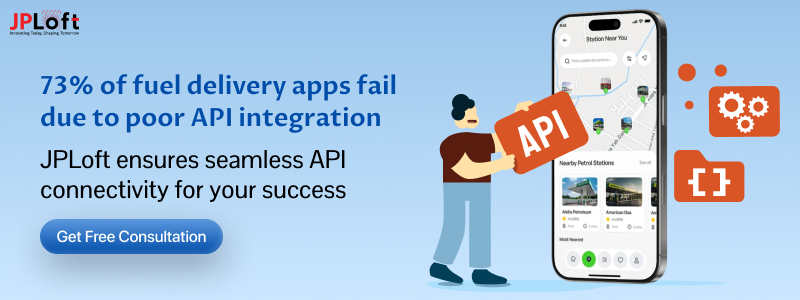
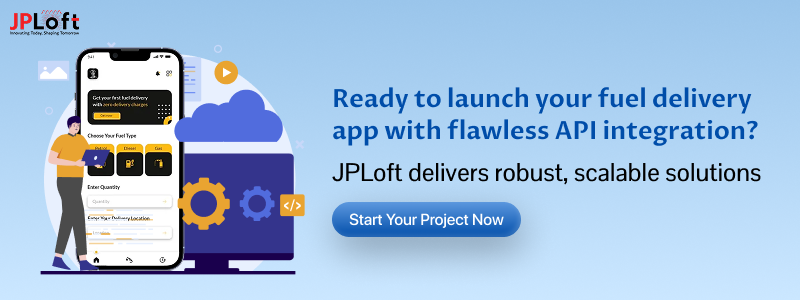

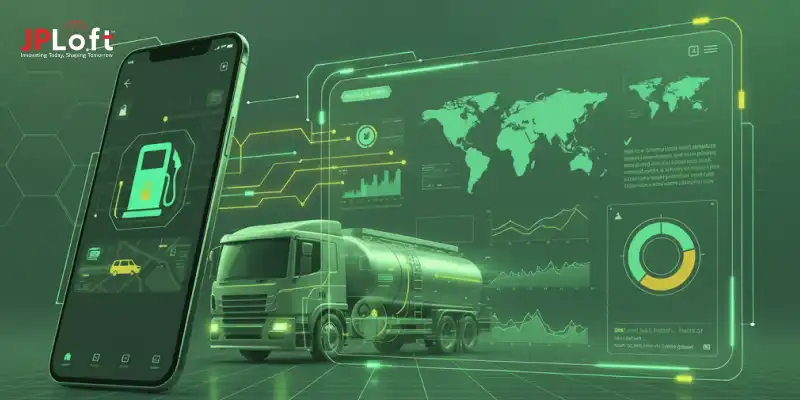
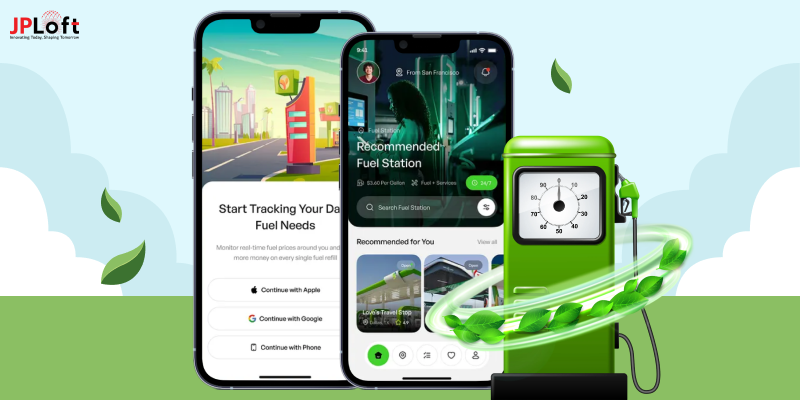
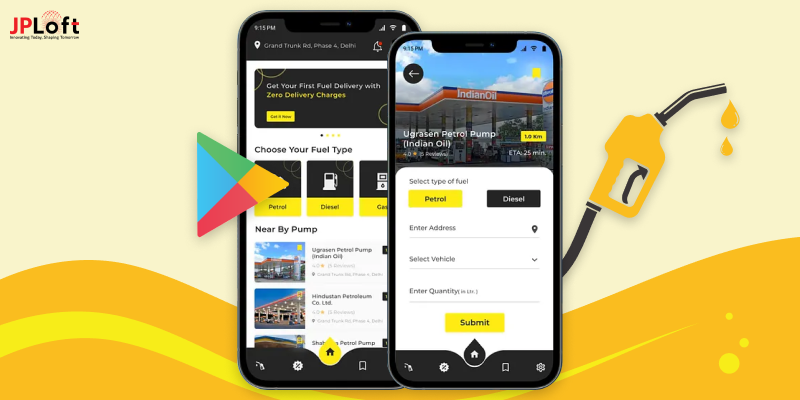


Share this blog